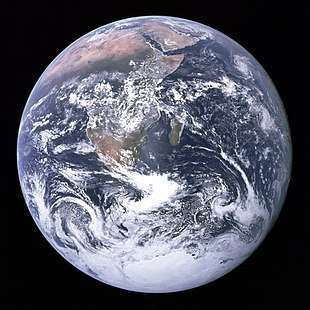Continent
A continent is one of several very large landmasses. Generally identified by convention rather than any strict criteria, up to seven regions are commonly regarded as continents. Ordered from largest in area to smallest, these seven regions are: Asia, Africa, North America, South America, Antarctica, Europe, and Australia.[1] Variations with fewer continents may merge some of these, for example some systems include Eurasia or America as single continents.
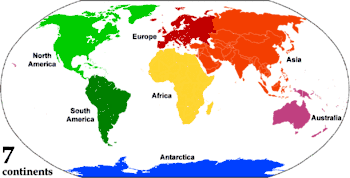
Geologically, the continents correspond to areas of continental crust that are found on the continental plates, but include continental fragments such as Madagascar that are not commonly referred to as continents. Some geological continents are largely covered with water, such as Zealandia (see submerged continents below). Continental crust is only known to exist on Earth.[2]
Oceanic islands are frequently grouped with a neighbouring continent to divide all the world's land into regions. Under this scheme, most of the island countries and territories in the Pacific Ocean are grouped together with the continent of Australia to form a region called Oceania.
Definitions and application
By convention, "continents are understood to be large, continuous, discrete masses of land, ideally separated by expanses of water."[3] In modern schemes with five or more recognised continents, at least one pair of continents is joined by land in some way. The criterion "large" leads to arbitrary classification: Greenland, with a surface area of 2,166,086 square kilometres (836,330 sq mi) is considered the world's largest island, while Australia, at 7,617,930 square kilometres (2,941,300 sq mi) is deemed the smallest continent.
Earth's major landmasses all have coasts on a single, continuous World Ocean, which is divided into a number of principal oceanic components by the continents and various geographic criteria.[4][5]
Extent
The most restricted meaning of continent is that of a continuous[6] area of land or mainland, with the coastline and any land boundaries forming the edge of the continent. In this sense the term continental Europe (sometimes referred to in Britain as "the Continent") is used to refer to mainland Europe, excluding islands such as Great Britain, Ireland, Malta and Iceland, and the term continent of Australia may refer to the mainland of Australia, excluding Tasmania and New Guinea. Similarly, the continental United States refers to the 48 contiguous states and the District of Columbia in central North America and may include Alaska in the northwest of the continent (the two being separated by Canada), while excluding Hawaii in the Pacific Ocean.
From the perspective of geology or physical geography, continent may be extended beyond the confines of continuous dry land to include the shallow, submerged adjacent area (the continental shelf)[7] and the islands on the shelf (continental islands), as they are structurally part of the continent.[8]
From this perspective, the edge of the continental shelf is the true edge of the continent, as shorelines vary with changes in sea level.[9] In this sense the islands of Great Britain and Ireland are part of Europe, while Australia and the island of New Guinea together form a continent.
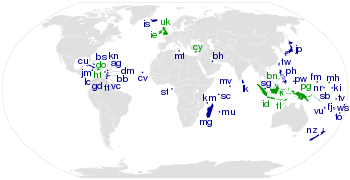
As a cultural construct, the concept of a continent may go beyond the continental shelf to include oceanic islands and continental fragments. In this way, Iceland is considered part of Europe and Madagascar part of Africa. Extrapolating the concept to its extreme, some geographers group the Australian continental plate with other islands in the Pacific into one "quasi-continent" called Oceania. This divides the entire land surface of Earth into continents or quasi-continents.[10]
Separation
The ideal criterion that each continent is a discrete landmass is commonly relaxed due to historical conventions. Of the seven most globally recognized continents, only Antarctica and Australia are completely separated from other continents by the ocean. Several continents are defined not as absolutely distinct bodies but as "more or less discrete masses of land".[11] Asia and Africa are joined by the Isthmus of Suez, and North and South America by the Isthmus of Panama. In both cases, there is no complete separation of these landmasses by water (disregarding the Suez Canal and Panama Canal, which are both narrow and shallow, as well as man-made). Both these isthmuses are very narrow compared to the bulk of the landmasses they unite.
North America and South America are treated as separate continents in the seven-continent model. However, they may also be viewed as a single continent known as America. This viewpoint was common in the United States until World War II, and remains prevalent in some Asian six-continent models.[12] This remains the more common vision in Latin American countries, Spain, Portugal, France, Italy, Germany, Greece and Hungary, where they are taught as a single continent.
The criterion of a discrete landmass is completely disregarded if the continuous landmass of Eurasia is classified as two separate continents: Europe and Asia. Physiographically, Europe and South Asia are peninsulas of the Eurasian landmass. However, Europe is widely considered a continent with its comparatively large land area of 10,180,000 square kilometres (3,930,000 sq mi), while South Asia, with less than half that area, is considered a subcontinent. The alternative view—in geology and geography—that Eurasia is a single continent results in a six-continent view of the world. Some view separation of Eurasia into Asia and Europe as a residue of Eurocentrism: "In physical, cultural and historical diversity, China and India are comparable to the entire European landmass, not to a single European country. [...]."[13] However, for historical and cultural reasons, the view of Europe as a separate continent continues in several categorizations.
If continents are defined strictly as discrete landmasses, embracing all the contiguous land of a body, then Africa, Asia, and Europe form a single continent which may be referred to as Afro-Eurasia.[14] Combined with the consolidation of the Americas, this would produce a four-continent model consisting of Afro-Eurasia, America, Antarctica and Australia.
When sea levels were lower during the Pleistocene ice ages, greater areas of continental shelf were exposed as dry land, forming land bridges. At those times Australia–New Guinea was a single, continuous continent. Likewise, the Americas and Afro-Eurasia were joined by the Bering land bridge. Other islands such as Great Britain were joined to the mainlands of their continents. At that time there were just three discrete continents: Afro-Eurasia-America, Antarctica, and Australia-New Guinea.
Number
There are several ways of distinguishing the continents:
| Models | |||||||||
|---|---|---|---|---|---|---|---|---|---|
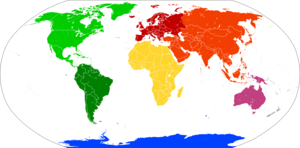 | |||||||||
| Four continents | Afro-Eurasia/Old World | America/New World | Antarctica | Australia | [14][15][16][17][18][19][20][21][22][22] | ||||
| Five continents | Africa | Eurasia | America | Antarctica | Australia | [23][24][25][26] | |||
| Six continents | Africa | Asia | Europe | America | Antarctica | Australia | [27] | ||
| Six continents | Africa | Eurasia | North America | South America | Antarctica | Australia | [28][29] | ||
| Seven continents | Africa | Asia | Europe | North America | South America | Antarctica | Australia | [28][30][31][32][33][34] | |
- The seven-continent model is usually taught in most English-speaking countries including the United States, United Kingdom[35] and Australia,[36] and also in China, India, Pakistan, the Philippines, and parts of Western Europe.
- The six-continent combined-Eurasia model is mostly used in Russia, Eastern Europe, and Japan.
- The six-continent combined-America model is often used in Latin America,[37] Greece,[27] and countries that speak Romance languages.
- A five-continent model is obtained from the combined-America model by excluding Antarctica as uninhabited. This is used in the United Nations[38] and in the Olympic Charter[39] in its description of the Olympic flag.
As previously mentioned, some geographers use the name Oceania for a region including most of the island countries and territories in the Pacific Ocean as well as the continent of Australia.
Area and population
The following table summarizes the area and population of the continental regions used by the United Nations.[40] These regions differ from the physical continents in various ways that are explained in the notes.
| Continent | Area (km²) |
Area (mi²) |
Percent total landmass |
Population | Percent total pop. |
Most populous city (proper) | |
|---|---|---|---|---|---|---|---|
| Africa | [note 1] | 30,370,000 | 11,730,000 | 20.4% | 1,287,920,000 | 16.9% | Lagos, Nigeria |
| Antarctica | [note 2] | 14,000,000 | 5,400,000 | 9.2% | 4,490[41] | 0.0% | McMurdo Station |
| Asia | [note 3] | 44,579,000 | 17,212,000 | 29.5% | 4,545,133,000 | 59.5% | Shanghai, China |
| Europe | [note 4] | 10,180,000 | 3,930,000 | 6.8% | 742,648,000 | 9.7% | Moscow, Russia[42] |
| North America | [note 5] | 24,709,000 | 9,540,000 | 16.5% | 587,615,000 | 7.7% | Mexico City, Mexico |
| Australia | [note 6] | 8,600,000 | 3,300,000 | 5.9% | 41,261,000 | 0.5% | Sydney, Australia |
| South America | 17,840,000 | 6,890,000 | 12.0% | 428,240,000 | 5.6% | São Paulo, Brazil |
- Includes the Sinai Peninsula in Egypt.
- Population is non-permanent and varies.
- Includes East Thrace (Turkey) and Western New Guinea (Indonesia), excludes European Russia and Egypt.
- Excludes Asiatic Russia, excludes Turkey.
- Includes Central America and the Caribbean.
- Excludes Indonesia.
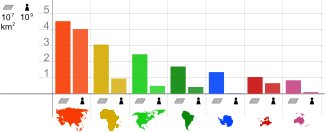 Comparison of area (by tens of millions of square kilometres) and population (by billions of people) | 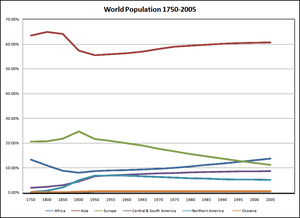 Graph showing population by continent as a percentage of world population (1750–2005) |
The total land area of all continents is 148,647,000 square kilometres (57,393,000 sq mi), or 29.1% of earth's surface (510,065,600 km2 or 196,937,400 sq mi).
Other divisions
Supercontinents
Aside from the conventionally known continents, the scope and meaning of the term continent varies. Supercontinents, largely in evidence earlier in the geological record, are landmasses that comprise more than one craton or continental core. These have included Laurasia, Gondwana, Vaalbara, Kenorland, Columbia, Rodinia, and Pangaea. Over time, these supercontinents broke apart into large land masses which caused the formation of the present continents.
Subcontinents
Certain parts of continents are recognized as subcontinents, especially the large peninsulas separated from the main continental landmass by geographical features. The most notable examples are the Indian subcontinent and the Arabian Peninsula.[43] The Southern Cone of South America and the Alaska Peninsula of North America are other examples.[43]
In many of these cases, the "subcontinents" concerned are on different tectonic plates from the rest of the continent, providing a geological justification for the terminology.[44] Greenland, generally reckoned as the world's largest island on the northeastern periphery of the North American Plate, is sometimes referred to as a subcontinent.[45][46] This is a significant departure from the more conventional view of a subcontinent as comprising a very large peninsula on the fringe of a continent.
Where the Americas are viewed as a single continent (America), it is divided into two subcontinents (North America and South America)[47][48][49] or three (with Central America being the third).[50][51] When Eurasia is regarded as a single continent, Europe is treated as a subcontinent.[43]
Submerged continents
Some areas of continental crust are largely covered by the sea and may be considered submerged continents. Notable examples are Zealandia, emerging from the sea primarily in New Zealand and New Caledonia, and the almost completely submerged Kerguelen Plateau in the southern Indian Ocean.
Microcontinents
Some islands lie on sections of continental crust that have rifted and drifted apart from a main continental landmass. While not considered continents because of their relatively small size, they may be considered microcontinents. Madagascar, the largest example, is usually considered an island of Africa, but its divergent evolution has caused it to be referred to as "the eighth continent" from a biological perspective.[52]
Botanical continents
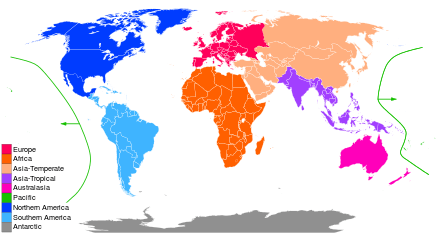
"Continents" may be defined differently for specific purposes. The Biodiversity Information Standards organization has developed the World Geographical Scheme for Recording Plant Distributions, used in many international plant databases. This scheme divides the world into nine "botanical continents". Some match the traditional geographical continents, but some differ significantly. Thus the Americas are divided between Northern America (Mexico northwards) and Southern America (Central America and the Caribbean southwards) rather than between North America and South America.[53]
History of continental configurations
History of the concept
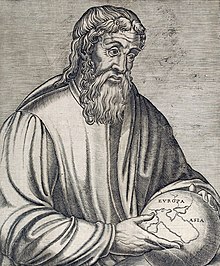
Early concepts of the Old World continents
The term "continent" translates Greek ἤπειρος, properly "landmass, terra firma", the proper name of Epirus and later especially used of Asia (i.e. Asia Minor),[54] The first distinction between continents was made by ancient Greek mariners who gave the names Europe and Asia to the lands on either side of the waterways of the Aegean Sea, the Dardanelles strait, the Sea of Marmara, the Bosporus strait and the Black Sea.[55] The names were first applied just to lands near the coast and only later extended to include the hinterlands.[56] But the division was only carried through to the end of navigable waterways and "... beyond that point the Hellenic geographers never succeeded in laying their finger on any inland feature in the physical landscape that could offer any convincing line for partitioning an indivisible Eurasia ..."[55]
Ancient Greek thinkers subsequently debated whether Africa (then called Libya) should be considered part of Asia or a third part of the world. Division into three parts eventually came to predominate.[57] From the Greek viewpoint, the Aegean Sea was the center of the world; Asia lay to the east, Europe to the north and west, and Africa to the south.[58] The boundaries between the continents were not fixed. Early on, the Europe–Asia boundary was taken to run from the Black Sea along the Rioni River (known then as the Phasis) in Georgia. Later it was viewed as running from the Black Sea through Kerch Strait, the Sea of Azov and along the Don River (known then as the Tanais) in Russia.[59] The boundary between Asia and Africa was generally taken to be the Nile River. Herodotus[60] in the 5th century BC objected to the whole of Egypt being split between Asia and Africa ("Libya") and took the boundary to lie along the western border of Egypt, regarding Egypt as part of Asia. He also questioned the division into three of what is really a single landmass,[61] a debate that continues nearly two and a half millennia later.
Eratosthenes, in the 3rd century BC, noted that some geographers divided the continents by rivers (the Nile and the Don), thus considering them "islands". Others divided the continents by isthmuses, calling the continents "peninsulas". These latter geographers set the border between Europe and Asia at the isthmus between the Black Sea and the Caspian Sea, and the border between Asia and Africa at the isthmus between the Red Sea and the mouth of Lake Bardawil on the Mediterranean Sea.[62]
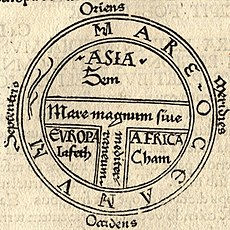
Through the Roman period and the Middle Ages, a few writers took the Isthmus of Suez as the boundary between Asia and Africa, but most writers continued to consider it the Nile or the western border of Egypt (Gibbon). In the Middle Ages, the world was usually portrayed on T and O maps, with the T representing the waters dividing the three continents. By the middle of the 18th century, "the fashion of dividing Asia and Africa at the Nile, or at the Great Catabathmus [the boundary between Egypt and Libya] farther west, had even then scarcely passed away".[63]
European arrival in the Americas
Christopher Columbus sailed across the Atlantic Ocean to the West Indies in 1492, sparking a period of European exploration of the Americas. But despite four voyages to the Americas, Columbus never believed he had reached a new continent—he always thought it was part of Asia.
In 1501, Amerigo Vespucci and Gonçalo Coelho attempted to sail around what they considered the southern end of the Asian mainland into the Indian Ocean, passing through Fernando de Noronha. After reaching the coast of Brazil, they sailed a long way further south along the coast of South America, confirming that this was a land of continental proportions and that it also extended much further south than Asia was known to.[64] On return to Europe, an account of the voyage, called Mundus Novus ("New World"), was published under Vespucci's name in 1502 or 1503,[65] although it seems that it had additions or alterations by another writer.[66] Regardless of who penned the words, Mundus Novus credited Vespucci with saying, "I have discovered a continent in those southern regions that is inhabited by more numerous people and animals than our Europe, or Asia or Africa",[67] the first known explicit identification of part of the Americas as a continent like the other three.
Within a few years, the name "New World" began appearing as a name for South America on world maps, such as the Oliveriana (Pesaro) map of around 1504–1505. Maps of this time though, still showed North America connected to Asia and showed South America as a separate land.[66]
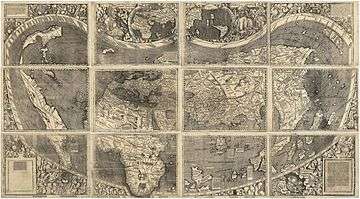
In 1507 Martin Waldseemüller published a world map, Universalis Cosmographia, which was the first to show North and South America as separate from Asia and surrounded by water. A small inset map above the main map explicitly showed for the first time the Americas being east of Asia and separated from Asia by an ocean, as opposed to just placing the Americas on the left end of the map and Asia on the right end. In the accompanying book Cosmographiae Introductio, Waldseemüller noted that the earth is divided into four parts, Europe, Asia, Africa and the fourth part, which he named "America" after Amerigo Vespucci's first name.[68] On the map, the word "America" was placed on part of South America.
The word continent
From the 16th century the English noun continent was derived from the term continent land, meaning continuous or connected land[69] and translated from the Latin terra continens.[70] The noun was used to mean "a connected or continuous tract of land" or mainland.[69] It was not applied only to very large areas of land—in the 17th century, references were made to the continents (or mainlands) of Isle of Man, Ireland and Wales and in 1745 to Sumatra.[69] The word continent was used in translating Greek and Latin writings about the three "parts" of the world, although in the original languages no word of exactly the same meaning as continent was used.[71]
While continent was used on the one hand for relatively small areas of continuous land, on the other hand geographers again raised Herodotus's query about why a single large landmass should be divided into separate continents. In the mid-17th century, Peter Heylin wrote in his Cosmographie that "A Continent is a great quantity of Land, not separated by any Sea from the rest of the World, as the whole Continent of Europe, Asia, Africa." In 1727, Ephraim Chambers wrote in his Cyclopædia, "The world is ordinarily divided into two grand continents: the old and the new." And in his 1752 atlas, Emanuel Bowen defined a continent as "a large space of dry land comprehending many countries all joined together, without any separation by water. Thus Europe, Asia, and Africa is one great continent, as America is another."[72] However, the old idea of Europe, Asia and Africa as "parts" of the world ultimately persisted with these being regarded as separate continents.
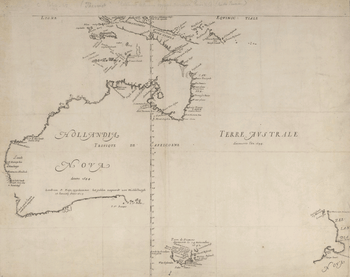
Beyond four continents
From the late 18th century, some geographers started to regard North America and South America as two parts of the world, making five parts in total. Overall though, the fourfold division prevailed well into the 19th century.[73]
Europeans discovered Australia in 1606, but for some time it was taken as part of Asia. By the late 18th century, some geographers considered it a continent in its own right, making it the sixth (or fifth for those still taking America as a single continent).[73] In 1813, Samuel Butler wrote of Australia as "New Holland, an immense island, which some geographers dignify with the appellation of another continent" and the Oxford English Dictionary was just as equivocal some decades later.[74] It was in the 1950s that the concept of Oceania as a "great division" of the world was replaced by the concept of Australia as a continent.[75]
Antarctica was sighted in 1820 during the First Russian Antarctic Expedition and described as a continent by Charles Wilkes on the United States Exploring Expedition in 1838, the last continent identified, although a great "Antarctic" (antipodean) landmass had been anticipated for millennia. An 1849 atlas labelled Antarctica as a continent but few atlases did so until after World War II.[76]
From the mid-19th century, atlases published in the United States more commonly treated North and South America as separate continents, while atlases published in Europe usually considered them one continent. However, it was still not uncommon for American atlases to treat them as one continent up until World War II.[77] From the 1950s, most U.S. geographers divided the Americas into two continents.[77] With the addition of Antarctica, this made the seven-continent model. However, this division of the Americas never appealed to Latin Americans, who saw their region spanning an América as a single landmass, and there the conception of six continents remains dominant, as it does in scattered other countries.
Some geographers regard Europe and Asia together as a single continent, dubbed Eurasia.[78] In this model, the world is divided into six continents, with North America and South America considered separate continents.
Geology
Geologists use the term continent in a different manner from geographers. In geology a continent is defined by continental crust: a platform of metamorphic and igneous rock, largely of granitic composition. Some geologists restrict the term 'continent' to portions of the crust built around stable Precambrian "shield", typically 1.5 to 3.8 billion years old, called a craton. The craton itself is an accretionary complex of ancient mobile belts (mountain belts) from earlier cycles of subduction, continental collision and break-up from plate tectonic activity. An outward-thickening veneer of younger minimally deformed sedimentary rock covers much of the craton. The margins of geologic continents are characterized by currently active or relatively recently active mobile belts and deep troughs of accumulated marine or deltaic sediments. Beyond the margin, there is either a continental shelf and drop off to the basaltic ocean basin or the margin of another continent, depending on the current plate-tectonic setting of the continent. A continental boundary does not have to be a body of water. Over geologic time, continents are periodically submerged under large epicontinental seas, and continental collisions result in a continent becoming attached to another continent. The current geologic era is relatively anomalous in that so much of the continental areas are "high and dry"; that is, many parts of the continents that were once below sea level are now elevated well above it due to changes in sea levels and the subsequent uplifting of those continental areas from tectonic activity.[79]
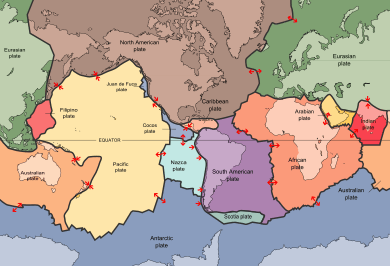
Some argue that continents are accretionary crustal "rafts" that, unlike the denser basaltic crust of the ocean basins, are not subjected to destruction through the plate tectonic process of subduction. This accounts for the great age of the rocks comprising the continental cratons. By this definition, Eastern Europe, India and some other regions could be regarded as continental masses distinct from the rest of Eurasia because they have separate ancient shield areas (i.e. East European craton and Indian craton). Younger mobile belts (such as the Ural Mountains and Himalayas) mark the boundaries between these regions and the rest of Eurasia.
There are many microcontinents, or continental fragments, that are built of continental crust but do not contain a craton. Some of these are fragments of Gondwana or other ancient cratonic continents: Zealandia,[80] which includes New Zealand and New Caledonia; Madagascar; the northern Mascarene Plateau, which includes the Seychelles. Other islands, such as several in the Caribbean Sea, are composed largely of granitic rock as well, but all continents contain both granitic and basaltic crust, and there is no clear boundary as to which islands would be considered microcontinents under such a definition. The Kerguelen Plateau, for example, is largely volcanic, but is associated with the break-up of Gondwanaland and is considered a microcontinent,[81][82] whereas volcanic Iceland and Hawaii are not. The British Isles, Sri Lanka, Borneo, and Newfoundland are margins of the Laurasian continent—only separated by inland seas flooding its margins.
Plate tectonics offers yet another way of defining continents. Today, Europe and most of Asia constitute the unified Eurasian Plate, which is approximately coincident with the geographic Eurasian continent excluding India, Arabia, and far eastern Russia. India contains a central shield, and the geologically recent Himalaya mobile belt forms its northern margin. North America and South America are separate continents, the connecting isthmus being largely the result of volcanism from relatively recent subduction tectonics. North American continental rocks extend to Greenland (a portion of the Canadian Shield), and in terms of plate boundaries, the North American plate includes the easternmost portion of the Asian landmass. Geologists do not use these facts to suggest that eastern Asia is part of the North American continent, even though the plate boundary extends there; the word continent is usually used in its geographic sense and additional definitions ("continental rocks," "plate boundaries") are used as appropriate.
The movement of plates has caused the formation and break-up of continents over time, including occasional formation of a supercontinent that contains most or all of the continents. The supercontinent Columbia or Nuna formed during a period of 2.0–1.8 billion years ago and broke up about 1.5–1.3 billion years ago.[83][84] The supercontinent Rodinia is thought to have formed about 1 billion years ago and to have embodied most or all of Earth's continents, and broken up into eight continents around 600 million years ago. The eight continents later re-assembled into another supercontinent called Pangaea; Pangaea broke up into Laurasia (which became North America and Eurasia) and Gondwana (which became the remaining continents).
Highest and lowest points
The following table lists the seven continents with their highest and lowest points on land, sorted in decreasing highest points.
| Continent | Highest point | Elevation | Country or territory containing highest point | Lowest point | Elevation | Country or territory containing lowest point | ||
|---|---|---|---|---|---|---|---|---|
| (metres) | (feet) | (metres) | (feet) | |||||
| Asia | Mount Everest | 8,848 | 29,029 | China, Nepal | Dead Sea | −427 | −1,401 | Israel, Jordan and Palestine |
| South America | Aconcagua | 6,960 | 22,830 | Argentina | Laguna del Carbón | −105 | −344 | Argentina |
| North America | Denali | 6,198 | 20,335 | United States | Death Valley† | −86 | −282 | United States |
| Africa | Mount Kilimanjaro | 5,895 | 19,341 | Tanzania | Lake Assal | −155 | −509 | Djibouti |
| Europe | Mount Elbrus | 5,642 | 18,510 | Russia | Caspian Sea | −28 | −92 | Russia |
| Antarctica | Vinson Massif | 4,892 | 16,050 | None | Deep Lake, Vestfold Hills† | −50 | −160 | None†† |
| Australia (continent) | Puncak Jaya | 4,884 | 16,024 | Indonesia (Papua) | Lake Eyre | −15 | −49 | Australia (country) |
† The lowest exposed points are given for North America and Antarctica. The lowest non-submarine bedrock elevations in these continents are the trough beneath Jakobshavn Glacier, at −1,512 metres (−4,961 ft)[85] and Bentley Subglacial Trench, at −2,540 metres (−8,330 ft), but these are covered by kilometres of ice.
†† Claimed by Australia as part of Australian Antarctic Territory, but this claim is not widely recognised.
Some sources list the Kuma–Manych Depression (a remnant of the Paratethys) as the geological border between Europe and Asia.[86][87] This would place the Caucasus outside of Europe, thus making Mont Blanc (elevation 4810 m) in the Graian Alps the highest point in Europe – the lowest point would still be the shore of the Caspian Sea.
See also
References
- "Continents: What is a Continent?". National Geographic. Archived from the original on 29 June 2009. "Most people recognize seven continents—Asia, Africa, North America, South America, Antarctica, Europe, and Australia, from largest to smallest—although sometimes Asia and Europe are considered a single continent, Eurasia."
- Science, Charles Q. Choi 2015-07-16T12:45:43Z; Astronomy. "Did Ancient Mars Have Continents?". Space.com. Retrieved 13 July 2019.
- Lewis & Wigen, The Myth of Continents (1997), p. 21.
- "Ocean". Columbia Encyclopedia (2006). New York: Columbia University Press. Retrieved 20 February 2007.
- "Distribution of land and water on the planet Archived 31 May 2008 at the Wayback Machine." UN Atlas of the Oceans Archived 15 September 2008 at the Wayback Machine (2004). Retrieved 20 February 2007.
- "continent n. 5. a." (1989) Oxford English Dictionary, 2nd edition. Oxford University Press; "continent1 n." (2006) The Concise Oxford English Dictionary, 11th edition revised. (Ed.) Catherine Soanes and Angus Stevenson. Oxford University Press; "continent1 n." (2005) The New Oxford American Dictionary, 2nd edition. (Ed.) Erin McKean. Oxford University Press; "continent [2, n] 4 a" (1996) Webster's Third New International Dictionary, Unabridged. ProQuest Information and Learning; "continent" (2007) Encyclopædia Britannica. Retrieved 14 January 2007, from Encyclopædia Britannica Online.
- "continent [2, n] 6" (1996) Webster's Third New International Dictionary, Unabridged. ProQuest Information and Learning. "a large segment of the earth's outer shell including a terrestrial continent and the adjacent continental shelf"
- Monkhouse, F. J.; John Small (1978). A Dictionary of the Natural Environment. London: Edward Arnold. pp. 67–68.
structurally it includes shallowly submerged adjacent areas (continental shelf) and neighbouring islands
- Ollier, Cliff D. (1996). Planet Earth. In Ian Douglas (Ed.), Companion Encyclopedia of Geography: The Environment and Humankind. London: Routledge, p. 30. "Ocean waters extend onto continental rocks at continental shelves, and the true edges of the continents are the steeper continental slopes. The actual shorelines are rather accidental, depending on the height of sea-level on the sloping shelves."
- Lewis & Wigen, The Myth of Continents (1997), p. 40: "The joining of Australia with various Pacific islands to form the quasi continent of Oceania ... "
- Lewis & Wigen, The Myth of Continents (1997), p. 35.
- Lewis & Wigen, The Myth of Continents (1997), Chapter 1: "While it might seem surprising to find North and South America still joined into a single continent in a book published in the United States in 1937, such a notion remained fairly common until World War II. [...] By the 1950s, however, virtually all American geographers had come to insist that the visually distinct landmasses of North and South America deserved separate designations."
- Lewis & Wigen, The Myth of Continents (1997), p. ?.
- R.W. McColl, ed. (2005). "continents". Encyclopedia of World Geography. 1. Facts on File, Inc. p. 215. ISBN 978-0-8160-7229-3. Retrieved 26 June 2012.
And since Africa and Asia are connected at the Suez Peninsula, Europe, Africa, and Asia are sometimes combined as Afro-Eurasia or Eurafrasia.
- "4 Continents This would probably be the correct subdivision if we adopted a strict definition of continents, ideally defined as large landmasses separated by water. Furthermore, we should consider "separated" only what is naturally separated, excluding therefore the separations resulting from the artificially made Panama Canal (which separates North and South America) and Suez Canal (which separates Africa from Eurasia). Under this model, the four continents of the world are: Afro-Eurasia (or Eurafrasia), America, and Australia (not Oceania, which combines Australia with smaller countries in the Pacific Ocean which are separated by water), and Antarctica. An alternative four-continent model, introduced at the beginning of the 20th centry, included Europe, Asia, Africa, and America."worldometers
- "If you count Europe and Asia as one continent (often known as Eurasia), then there are six continents. Some people also count North America and South America as one continent (called simply America), since the two land masses are separated only by the human-made Panama Canal. This would allow for a model with only five continents."wonderopolis
- Christoph Strobel (11 February 2015). The Global Atlantic: 1400 to 1900. Routledge. pp. 13–. ISBN 978-1-317-52552-3.
- Manual of Modern Geography: 2. William Blackwood. 1870. pp. 18–.
- Ross E. Dunn; Laura J. Mitchell; Kerry Ward (23 August 2016). The New World History: A Field Guide for Teachers and Researchers. Univ of California Press. pp. 232–. ISBN 978-0-520-28989-5.
- Sankar Chatterjee (13 March 2015). The Rise of Birds: 225 Million Years of Evolution. JHU Press. pp. 204–. ISBN 978-1-4214-1614-4.
- Alexander Mackay (1861). Manual of Modern Geography: Mathematical, Physical, and Political : on a New Plan : Embracing a Complete Development of the River Systems of the Globe. W. Blackwood and Sons. pp. 15–.
- D. M. Kermack (9 March 2013). The Evolution of Mammalian Characters. Springer Science & Business Media. pp. 141–. ISBN 978-1-4684-7817-4.
- "In some textbooks, North and South America are combined into "America" and/or Europe and Asia are combined into "Eurasia", for a grant total of 6 or even 5."scienceline
- Martin W. Lewis and Kären E. Wigen, The Myth of Continents: A Critique of Metageography (Berkeley and Los Angeles: University of California Press, 1997)Wigen
- "5 Continents This model adopts the criteria of both the six-continent models, resulting in the following 5 continents: Africa, Eurasia, America, Oceania (or Australia), and Antarctica. An alternative five-continent model is the one adopted, among others, by the Olympic Charter, which excludes Antarctica as uninhabited and lists the following five: Africa, Europe, Asia, America, and Oceania (or Australia)."worldometers2
- "There are even geographical views that prefer the presence of both a Eurasian as well as one American continent. These geographers therefore contend that there should only be 5 continents."universetoday
- Older/previous official Greek Paedagogical Institute 6th grade Geography textbook (at the Wayback Machine), 5+1 continents combined-America model; Pankosmios Enyklopaidikos Atlas, CIL Hellas Publications, ISBN 84-407-0470-4, p. 30, 5+1 combined-America continents model; Neos Eikonographemenos Geographikos Atlas, Siola-Alexiou, 6 continents combined-America model; Lexico tes Hellenikes Glossas, Papyros Publications, ISBN 978-960-6715-47-1, lemma continent (epeiros), 5 continents model; Lexico Triantaphyllide online dictionary, Greek Language Center (Kentro Hellenikes Glossas), lemma continent (epeiros), 6 continents combined-America model; Lexico tes Neas Hellenikes Glossas, G.Babiniotes, Kentro Lexikologias (Legicology Center) LTD Publications, ISBN 960-86190-1-7, lemma continent (epeiros), 6 continents combined-America model
- "Continent". Encyclopædia Britannica. 2006. Chicago: Encyclopædia Britannica, Inc.
- "Continent Archived 2 February 2007 at the Wayback Machine". The Columbia Encyclopedia Archived 5 February 2002 at the Wayback Machine . 2001. New York: Columbia University Press - Bartleby.
- World, National Geographic - Xpeditions Atlas. 2006. Washington, DC: National Geographic Society.
- The World - Continents Archived 21 February 2006 at the Wayback Machine, Atlas of Canada
- The New Oxford Dictionary of English. 2001. New York: Oxford University Press.
- "Continent Archived 31 October 2009 at WebCite". MSN Encarta Online Encyclopedia 2006.. 2009-10-31.
- "Continent". McArthur, Tom, ed. 1992. The Oxford Companion to the English Language. New York: Oxford University Press; p. 260.
- "National curriculum in England: geography programmes of study". UK Department for Education.
- "F-10 Curriculum Geograph". Australian Curriculum, Assessment, and Reporting Authority. Archived from the original on 24 March 2014.
- "Real Academia Española". Lema.rae.es. Retrieved 30 September 2013.
- "United Nations Statistics Division- Standard Country and Area Codes Classifications (M49)". unstats.un.org. Retrieved 9 November 2016.
- "Preamble" (PDF). Olympic Charter. International Olympic Committee. 8 December 2014. p. 10. Retrieved 7 August 2015.
the five interlaced rings, which represent the union of the five continents
- "World Population Prospects, the 2017 Revision. United Nations Department of Economic and Social Affairs. July 2017. Retrieved 14 July 2018". Archived from the original on 22 March 2018. Retrieved 19 November 2017.
- See also Demographics of Antarctica. Antarctica. CIA World Factbook. March 2011 data. Retrieved 24 December 2011.
- "Forbes проигнорировал Москву". irn.ru.
- Baldwin, James A. (2014), "Continents", in R.W. McColl (ed.), Encyclopedia of World Geography, Infobase Publishing, p. 215, ISBN 978-0-8160-7229-3
- Molnar, Peter (2015), Plate Tectonics: A Very Short Introduction, OUP Oxford, ISBN 978-0-19-104396-3
- p. 98: Thus, we can calculate past positions of the India plate, with the Indian subcontinent as its passenger, with respect to the Eurasia plate.
- p. 116: The Arabian subcontinent later, approximately 35 million years ago, collided with southern Eurasia to form the Zagros Mountains of southwestern Iran.
- Nares Strait and the drift of Greenland: a conflict in plate tectonics, Museum Tusculanum Press, 1982, pp. 32–, ISBN 978-87-635-1150-6
- Farmer, G. Thomas; Cook, John (2013), Climate Change Science: A Modern Synthesis: Volume 1 - The Physical Climate, Springer Science & Business Media, pp. 281–, ISBN 978-94-007-5757-8
- Gallay, Alan (2015), Colonial Wars of North America, 1512–1763 (Routledge Revivals): An Encyclopedia, Routledge, pp. 204–, ISBN 978-1-317-48719-7
- Innes, John L.; Haron, Abu Hassan (2000), Air Pollution and the Forests of Developing and Rapidly Industrializing Regions, CABI, pp. 36–, ISBN 978-0-85199-932-6
- Vivares, Dr Ernesto (2014). Exploring the New South American Regionalism (NSAR). Ashgate Publishing, Ltd. pp. 40–. ISBN 978-1-4094-6961-2.
- Leonard, Thomas M. (2005), Encyclopedia of the Developing World, Psychology Press, pp. 1637–, ISBN 978-1-57958-388-0
- In Ibero-America, North America usually designates a region (subcontinente in Spanish) of the Americas containing Canada, the United States, and Mexico, and often Greenland, Saint Pierre and Miquelon, and Bermuda; the land bridge of Central America is generally considered a subregion of North America.Norteamérica (Mexican version) Archived 30 January 2009 at the Wayback Machine/(Spaniard version) Archived 29 January 2009 at the Wayback Machine. Encarta Online Encyclopedia.. 2009-10-31.
- Hillstrom, Kevin; Collier Hillstrom, Laurie (2003). Africa and the Middle East: a continental overview of environmental issues. Santa Barbara, CA: ABC-CLIO. p. 50. ISBN 978-1-57607-688-0.
- Brummitt, R.K. (2001). World Geographical Scheme for Recording Plant Distributions: Edition 2 (PDF). International Working Group on Taxonomic Databases For Plant Sciences (TDWG). Retrieved 27 November 2006.CS1 maint: ref=harv (link)
- Henry George Liddell, Robert Scott, Henry Stuart Jones, A Greek-English Lexicon (1940), s.v. ἤπειρος. The English noun was introduced in the mid-16th century, shortened from continent land (15th century), adapted from Latin terra continens "continuous landmass".
- Toynbee, Arnold J. (1954). A Study of History. London: Oxford University Press, v. 8, pp. 711–712.
- Tozer, H. F. (1897). A History of Ancient Geography. Cambridge: University Press. p. 69.
- Tozer, H. F. (1897). A History of Ancient Geography. Cambridge: University Press. p. 67.
- Lewis & Wigen, The Myth of Continents (1997), pp. 21–22.
- Tozer, H. F. (1897). A History of Ancient Geography. Cambridge: University Press. p. 68.
- Herodotus. Translated by George Rawlinson (2000). The Histories of Herodotus of Halicarnassus . Ames, Iowa: Omphaloskepsis, book 2, p. 18. Archived 19 August 2006 at the Wayback Machine
- Herodotus. Translated by George Rawlinson (2000). The Histories of Herodotus of Halicarnassus "Archived copy" (PDF). Archived from the original (PDF) on 19 August 2006. Retrieved 8 February 2016.CS1 maint: archived copy as title (link). Ames, Iowa: Omphaloskepsis, book 4, p. 38. "I cannot conceive why three names ... should ever have been given to a tract which is in reality one,"
- Strabo. Translated by Horace Leonard Jones (1917). Geography. Harvard University Press, book 1, ch. 4.
- Goddard, Farley Brewer (1884). "Researches in the Cyrenaica". The American Journal of Philology, 5 (1) p. 38.
- O'Gorman, Edmundo (1961). The Invention of America. Indiana University Press. pp. 106–112.
- Formisano, Luciano (Ed.) (1992). Letters from a New World: Amerigo Vespucci's Discovery of America. New York: Marsilio, pp. xx–xxi. ISBN 0-941419-62-2.
- Zerubavel, Eviatar (2003). Terra Cognita: The Mental Discovery of America. New Brunswick: Transaction Publishers, pp. 77–79. ISBN 0-7658-0987-7.
- Formisano, Luciano (Ed.) (1992). Letters from a New World: Amerigo Vespucci's Discovery of America. New York: Marsilio, p. 45. ISBN 0-941419-62-2.
- Zerubavel, Eviatar (2003). Terra Cognita: The Mental Discovery of America. New Brunswick: Transaction Publishers, pp. 80–82. ISBN 0-7658-0987-7.
- "continent n." (1989) Oxford English Dictionary, 2nd edition. Oxford University Press.
- "continent1 n." (2006) The Concise Oxford English Dictionary, 11th edition revised. (Ed.) Catherine Soanes and Angus Stevenson. Oxford University Press.
- Lewis & Wigen, The Myth of Continents (1997), p. 29.
- Bowen, Emanuel. (1752). A Complete Atlas, or Distinct View of the Known World. London, p. 3.
- Lewis & Wigen, The Myth of Continents (1997), p. 30
- "continent n. 5. a." (1989) Oxford English Dictionary, 2nd edition. Oxford University Press. "the great island of Australia is sometimes reckoned as another [continent]"
- Lewis & Wigen, The Myth of Continents (1997), p. 32: "...the 1950s... was also the period when... Oceania as a "great division" was replaced by Australia as a continent along with a series of isolated and continentally attached islands. [Footnote 78: When Southeast Asia was conceptualized as a world region during World War II..., Indonesia and the Philippines were perforce added to Asia, which reduced the extent of Oceania, leading to a reconceptualization of Australia as a continent in its own right. This maneuver is apparent in postwar atlases]"
- Lewis, Martin W.; Kären E. Wigen (1997). The Myth of Continents: a Critique of Metageography. Berkeley: University of California Press. ISBN 978-0-520-20743-1.
- Lewis, Martin W.; Kären E. Wigen (1997). The Myth of Continents: a Critique of Metageography. Berkeley: University of California Press. p. 32. ISBN 978-0-520-20742-4.
- Some geographers list only six continents, combining Europe and Asia into Eurasia. In parts of the world, students learn that there are just five continents: Eurasia, Australia, Africa, Antarctica, and the Americas."How many continents are there?". National Geographic Society. Retrieved 26 September 2010.
- Kominz, Michelle A. (2001). "Sea level variations over geologic time" (PDF). Encyclopedia of Ocean Sciences. San Diego: Academic Press. p. 2609.
- Mortimer, N.; Campbell, H.J.; Tulloch, A.J.; King, P.R.; Stagpoole, V.M.; Wood, R.A.; Rattenbury, M.S.; Sutherland, R.; Adams, C.J.; Collot, J.; Seton, M. (2017). "Zealandia: Earth's Hidden Continent". GSA Today. 27 (3): 27–35. doi:10.1130/GSATG321A.1.
- "UT Austin scientist plays major rule in study of underwater "micro-continent"". Utexas.edu. Archived from the original on 3 November 2007. Retrieved 26 August 2012.
- "Sci/Tech | 'Lost continent' discovered". BBC News. 27 May 1999. Retrieved 26 August 2012.
- Zhao, Guochun; Cawood, Peter A.; Wilde, Simon A.; Sun, M. (November 2002). "Review of global 2.1–1.8 Ga orogens: implications for a pre-Rodinia supercontinent". Earth-Science Reviews. 59 (1): 125–162. Bibcode:2002ESRv...59..125Z. doi:10.1016/S0012-8252(02)00073-9.
- Zhao, Guochun; Sun, M.; Wilde, Simon A.; Li, S.Z. (November 2004). "A Paleo-Mesoproterozoic supercontinent: assembly, growth and breakup". Earth-Science Reviews. 67 (1): 91–123. Bibcode:2004ESRv...67...91Z. doi:10.1016/j.earscirev.2004.02.003.
- Plummer, Joel. Jakobshavn Bed Elevation Archived 27 June 2010 at the Wayback Machine, Center for the Remote Sensing of the Ice Sheets, Dept of Geography, University of Kansas.
- "'Kuma-Manych Depression'. Encyclopædia Britannica. Encyclopædia Britannica Online". Encyclopædia Britannica Inc., 2015. Retrieved 3 December 2015.
- "3. The continent - Extent and boundaries". Europe's Environment - The Dobris Assessment. European Environmental Agency. 2011.
Bibliography
- Lewis, Martin W.; Wigen, Kären E. (1997). The Myth of Continents: a Critique of Metageography. Berkeley: University of California Press. ISBN 978-0-520-20743-1.
External links
| Wikimedia Commons has media related to: |
- "What are continents?" YouTube video by CGP Grey
- . Encyclopædia Britannica (11th ed.). 1911.
- Lost continent revealed in new reconstruction of geologic history
.svg.png)
.svg.png)
.svg.png)
.svg.png)
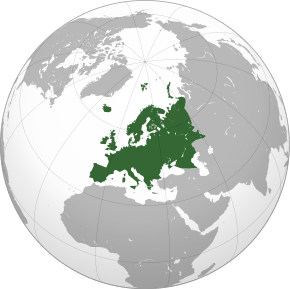
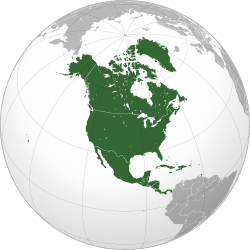
.svg.png)
_political.svg.png)
.svg.png)
.svg.png)
.svg.png)
